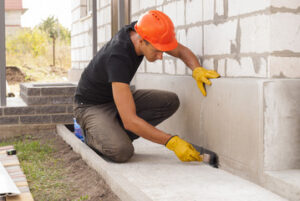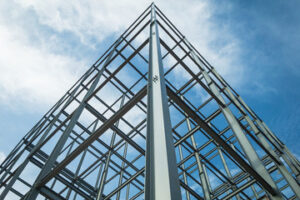Have your doors or windows been getting harder to open and close? That could be a sign of foundation settlement.

It’s important to make sure you hire an expert for your foundation repair project. The contractor should be able to clearly explain what the problem is and how they’ll fix it. Contact Sugar Land Foundation Repair Solutions for professional help.
Injected epoxy resin is a quick and effective repair method for concrete cracks. It can be used to fill cracks in slabs, walls and structures, including stairways, walkways, basement floors, beams and columns. It can also repair damage caused by impact, vehicle loads and earthquakes. Cracks in concrete structures can lead to loss of structural integrity, which can put people and equipment at risk. Proper diagnosis and timely repair of these problems can help prevent serious consequences.
To use this technique, injection ports are drilled or glued into the surface of the structure near the crack locations. These are then bridged with epoxy paste to form a seal that prevents the injection process from leaking. The cracks, voids and delaminations are then filled with an epoxy mixture that can be adjusted to the appropriate viscosity for each type of structure and environmental conditions. Once the epoxy has cured, the injection ports can be removed.
Unlike other repair techniques, which may require extensive excavation and disruption to the property, epoxy injection is a non-invasive method for repairing cracks in concrete. Injection ports can be installed in a wide range of locations to accommodate different project requirements, making this an ideal repair method for residential, commercial and industrial properties.
This type of repair can be utilized to address a variety of structural issues, such as soil compaction and settlement. It can be a good solution for homes and other structures with pier and beam foundations, as well as slab on grade construction. It can be used to stabilize sagging slabs and lift them back into place, which is often referred to as “mudjacking.”
The effectiveness of this repair method can depend on the cause and severity of the damage. It is important to determine the root cause of the problem and remedy it before injecting concrete, as this can ensure that the repairs are long-lasting. It is also important to use a qualified professional for this type of service, as they will have the necessary equipment and expertise required for proper application.
Slab Jacking
Slab jacking is a non-invasive technique for lifting concrete slabs that have sunken due to a variety of factors. It’s quick, cost-effective and can prevent future sinking with minimal disruption to your home or business. It can even be done year-round, barring extreme weather conditions, and requires no concrete removal or replacement.
Unlike other foundation repair methods, such as underpinnings, which require drilling and hauling away the old foundation to replace it with a new one, slab jacking lifts and repairs the existing concrete. This makes it a much less destructive process and can usually be done in just one day, meaning little interruption to your life or business. Slab jacking uses polyurethane foam which fills the voids under your slab, raising it back up to its original height and preventing further sinking.
This type of repair can be used on walkways, patios, garage floors, driveways, basements and more. The process involves drilling holes into the existing slab, then pumping a semi-liquid mixture that includes cement and soda ash or urethane foam under the slab to raise it back up to its original level. It’s also known as mudjacking, concrete lifting, and pressure grouting.
When concrete sinks, it’s often caused by voids underneath the slab, as well as soil erosion. Over time, this can lead to the foundation becoming unstable and prone to further movement. The use of slab jacking can help halt and reverse this sagging, as it’ll fill in the voids under your foundation and stabilize it.
Slab jacking can be performed in just a few hours and will require no excavation or heavy equipment to complete the job. Since it doesn’t involve breaking up and disposing of the existing concrete, there’s less cleanup involved as well. Additionally, there’s no concrete dust and minimal debris that would otherwise be produced during other types of repair processes.
There are services that offer to grind off the lip of your good slab to fix a trip hazard, but this doesn’t address the root cause of the issue. Slab jacking will, however, as it will fill the voids under the good section of your foundation and prevent further sinking and movement.
Concrete Leveling
Concrete leveling is a foundation repair technique that corrects uneven or sunken concrete surfaces. The process involves injecting a specialized material beneath the concrete, raising and aligning it to its initial position, which enhances safety and aesthetic appeal.
Uneven concrete slabs often serve as tripping hazards and can be especially dangerous for elderly or mobility-challenged individuals. In addition, they can weaken the overall structure of your home or commercial property. These concerns can be difficult to ignore, and it’s important to address them as soon as you notice any signs of sinking or unevenness.
Ignoring damaged and uneven concrete can lead to more serious problems in the future, including foundation instability, structural damage, and even water leaks. When you notice any of these issues, it’s advisable to seek professional assistance immediately.
Fortunately, there are several effective and long-lasting foundation repair options available to address these issues. Consult with a concrete foundation specialist to learn more about which solution is right for you and your property.
The most cost-effective and long-lasting solution is steel piers, which are driven into the ground beneath your house until they reach bedrock or compacted soil that can support the weight of your structure. They’re also an excellent option for repairing homes that have experienced significant shifting and settling.
Poured concrete piers are another option for stabilizing your foundation. They’re constructed by digging a hole below your home, filling it with wet concrete, and allowing it to cure. This method can also be used to lift and level concrete slabs.
Mudjacking and self-leveling concrete are other methods for addressing uneven concrete, but they’re typically only used indoors. Mudjacking uses a slurry mixture to fill low spots in your concrete and raise it back to its original position. This method requires extensive cleanup and can be quite messy. Self-leveling concrete is a more effective and cleaner alternative to mudjacking, using a polymer-modified cement that spreads evenly on its own without the need for extensive manual spreading.
Replacing sunken or cracked concrete is expensive and time-consuming, but it’s sometimes necessary to ensure the safety of your property and those who live or work on it. Fortunately, catching concrete problems early with concrete leveling techniques like PolyRenewal polyurethane foam injection can save you a lot of money.
Foundation Wall Repair
Foundation wall cracks are often signs of a serious problem that needs attention. A professional can inspect the damage to determine if it is structural, and what steps need to be taken to fix the issue. Some cracks are the result of shrinkage of concrete, and can be a normal part of the foundation settlement process. In other cases, the movement of soil can cause the foundation to shift, leading to a gap between the foundation and the home. In these cases, a professional will likely recommend a method to stabilize the foundation walls in place and prevent further damage.
A common repair technique is to fill the gap with steel shims, which can provide temporary support while the foundation settles. However, gaps may reappear, and more invasive repairs will likely be needed. Shims can also be used as a supplement to more extensive methods of support, such as the addition of pier stacks or the rebuilding of foundation pillars.
Another way to fix foundation wall problems is with a high-density polyurethane foam, which is injected into the crack in a process called foam jacking. This method is more cost-effective than traditional concrete repairing, but won’t last as long. Foam jacking is a good choice for emergency foundation repairs, or when the problem is time-sensitive.
For bowing or buckling walls, a professional can use a method known as wall anchors to stop the inward movement and potentially straighten the foundation walls over time. This solution uses the soils beyond the foundation walls to exert counter pressure on the failing walls, which can help to stabilize and restore the wall. This method is recommended when access to the soils is not restricted, and is a great alternative when other solutions such as push piers or caissons are not practical.
It is important to be aware that some contractors will try to earn your business by offering a quick and cheap solution. These methods, such as painting over drywall cracks or tuckpointing brick veneer, are short-term fixes that will only cover up the issues. Unless the underlying problem is addressed, these types of repair will only mask your foundation problems and leave you with more costly repairs down the road. To avoid these types of contractors, educate yourself on different repair methods and always choose a company that has their products evaluated by the ICC-ES.
